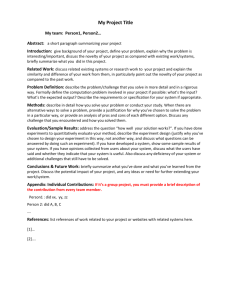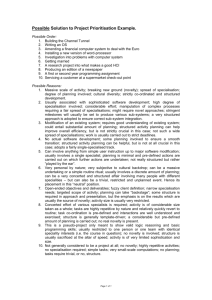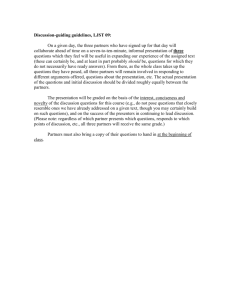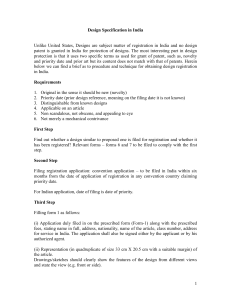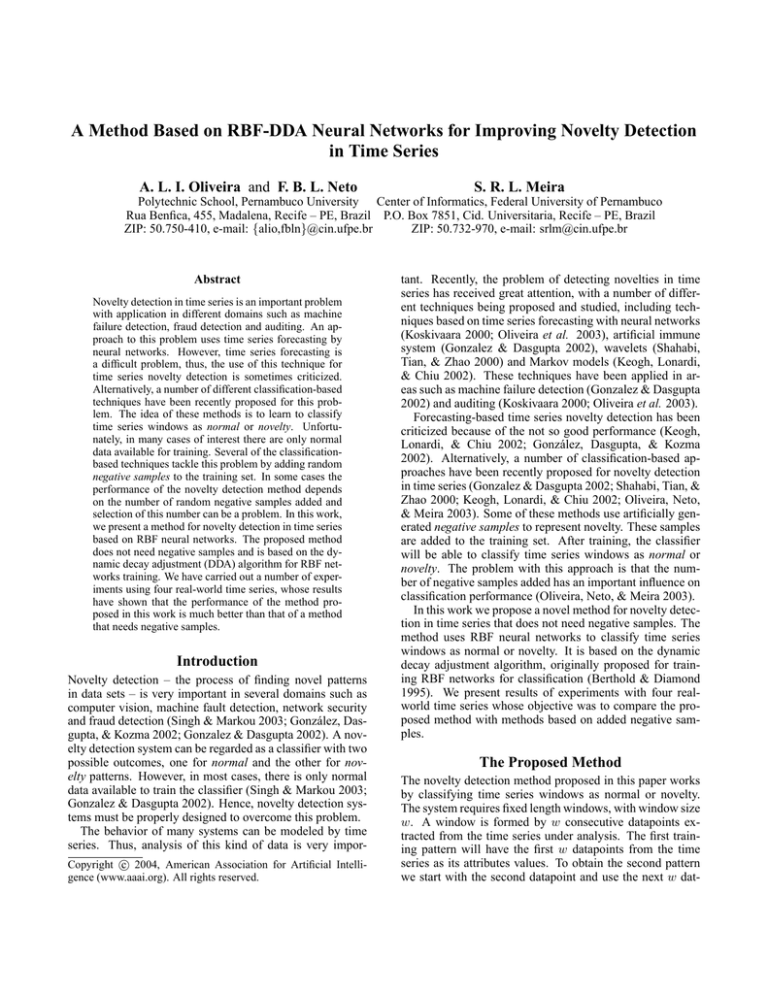
A Method Based on RBF-DDA Neural Networks for Improving Novelty Detection
in Time Series
A. L. I. Oliveira and F. B. L. Neto
S. R. L. Meira
Polytechnic School, Pernambuco University Center of Informatics, Federal University of Pernambuco
Rua Benfica, 455, Madalena, Recife – PE, Brazil P.O. Box 7851, Cid. Universitaria, Recife – PE, Brazil
ZIP: 50.750-410, e-mail: {alio,fbln}@cin.ufpe.br
ZIP: 50.732-970, e-mail: srlm@cin.ufpe.br
Abstract
Novelty detection in time series is an important problem
with application in different domains such as machine
failure detection, fraud detection and auditing. An approach to this problem uses time series forecasting by
neural networks. However, time series forecasting is
a difficult problem, thus, the use of this technique for
time series novelty detection is sometimes criticized.
Alternatively, a number of different classification-based
techniques have been recently proposed for this problem. The idea of these methods is to learn to classify
time series windows as normal or novelty. Unfortunately, in many cases of interest there are only normal
data available for training. Several of the classificationbased techniques tackle this problem by adding random
negative samples to the training set. In some cases the
performance of the novelty detection method depends
on the number of random negative samples added and
selection of this number can be a problem. In this work,
we present a method for novelty detection in time series
based on RBF neural networks. The proposed method
does not need negative samples and is based on the dynamic decay adjustment (DDA) algorithm for RBF networks training. We have carried out a number of experiments using four real-world time series, whose results
have shown that the performance of the method proposed in this work is much better than that of a method
that needs negative samples.
Introduction
Novelty detection – the process of finding novel patterns
in data sets – is very important in several domains such as
computer vision, machine fault detection, network security
and fraud detection (Singh & Markou 2003; González, Dasgupta, & Kozma 2002; Gonzalez & Dasgupta 2002). A novelty detection system can be regarded as a classifier with two
possible outcomes, one for normal and the other for novelty patterns. However, in most cases, there is only normal
data available to train the classifier (Singh & Markou 2003;
Gonzalez & Dasgupta 2002). Hence, novelty detection systems must be properly designed to overcome this problem.
The behavior of many systems can be modeled by time
series. Thus, analysis of this kind of data is very imporc 2004, American Association for Artificial IntelliCopyright gence (www.aaai.org). All rights reserved.
tant. Recently, the problem of detecting novelties in time
series has received great attention, with a number of different techniques being proposed and studied, including techniques based on time series forecasting with neural networks
(Koskivaara 2000; Oliveira et al. 2003), artificial immune
system (Gonzalez & Dasgupta 2002), wavelets (Shahabi,
Tian, & Zhao 2000) and Markov models (Keogh, Lonardi,
& Chiu 2002). These techniques have been applied in areas such as machine failure detection (Gonzalez & Dasgupta
2002) and auditing (Koskivaara 2000; Oliveira et al. 2003).
Forecasting-based time series novelty detection has been
criticized because of the not so good performance (Keogh,
Lonardi, & Chiu 2002; González, Dasgupta, & Kozma
2002). Alternatively, a number of classification-based approaches have been recently proposed for novelty detection
in time series (Gonzalez & Dasgupta 2002; Shahabi, Tian, &
Zhao 2000; Keogh, Lonardi, & Chiu 2002; Oliveira, Neto,
& Meira 2003). Some of these methods use artificially generated negative samples to represent novelty. These samples
are added to the training set. After training, the classifier
will be able to classify time series windows as normal or
novelty. The problem with this approach is that the number of negative samples added has an important influence on
classification performance (Oliveira, Neto, & Meira 2003).
In this work we propose a novel method for novelty detection in time series that does not need negative samples. The
method uses RBF neural networks to classify time series
windows as normal or novelty. It is based on the dynamic
decay adjustment algorithm, originally proposed for training RBF networks for classification (Berthold & Diamond
1995). We present results of experiments with four realworld time series whose objective was to compare the proposed method with methods based on added negative samples.
The Proposed Method
The novelty detection method proposed in this paper works
by classifying time series windows as normal or novelty.
The system requires fixed length windows, with window size
w. A window is formed by w consecutive datapoints extracted from the time series under analysis. The first training pattern will have the first w datapoints from the time
series as its attributes values. To obtain the second pattern
we start with the second datapoint and use the next w dat-
1
0.9
0.8
Novelty
Normal
0.7
0.6
by the training algorithm as needed. The number of units in
the output layer corresponds to the number of classes in the
problem. The centers and standard deviations of RBF units
are also determined by the training algorithm. The winnertakes-all rule is used for classification.
Input Layer
Hidden Layer
Output Layer
0.5
0.4
A
Novelty
1
First
0.3
A
Month
2
0.2
Figure 1: Definition of normal and novelty regions.
Second
Month
apoints. The remaining patterns are obtained by sliding the
window by one and taking the next w datapoints. So, if we
have a time series with l datapoints and use window size w,
we will have l − w + 1 patterns. These patterns will later be
separated to obtain training and test sets.
Given a window from the time series, the idea is to define an envelope around it as shown in figure 1. Any time
series window with all values inside the envelope is considered normal. Windows with points outside the envelope
are considered novelty. We use a threshold p1 to define the
envelope. Normal patterns are defined by establishing the
maximum percent deviation p1 above and below each datapoint of a given original pattern.
Our method uses radial basis functions (RBFs) in order
to define the region of normality shown in figure 1. In this
work we use radial Gaussians, the commonest type of RBF.
A RBF unit works by computing the Euclidian distance to
→
an individual reference vector −
ri , giving an output
−
→
||→
x −−
ri ||2
→
−
(1)
Ri ( x ) = exp −
σi2
→
→
→
where −
x is the input vector and ||−
x −−
ri || is the Euclidian
→
−
distance between the input vector x and the Gaussian cen→
ter −
ri . The Gaussian center will correspond to a normal time
series window. The standard deviation σi should be adjusted
to make the RBF unit produce a low output for values outside the envelope. We use the dynamic decay adjustment – a
constructive training algorithm for RBF networks (Berthold
& Diamond 1995) – to adjust Gaussian standard deviations
properly.
The DDA algorithm is a constructive algorithm used
to build and train RBF networks for classification tasks
(Berthold & Diamond 1995). It does not need a validation
set and so, all training data can be more effectively used for
training. RBF-DDA has often achieved classification accuracy comparable to multi-layer perceptron networks (MLPs)
but training is significantly faster. RBF-DDA neural networks have a single hidden layer with RBF units fully connected to the input layer, as shown in figures 2 and 3. The
number of units in the input layer depends on the dimensionality of the problem. Units in the hidden layer are added
..
.
Twelfth
Month
..
.
Am−1
Σ
Σ
Σ
Normal
Novelty
(upper envelope)
Novelty
(lower envelope)
Am
Figure 2: RBF network with three output units for
classification-based novelty detection.
In our novelty detection method, we generate, for each
original time series window pattern, two additional patterns.
The first corresponds to the upper envelope and the second,
to the lower one. That is, the first additional pattern is obtained from the original by adding the percent deviation p1
that defines the upper envelope. The second additional pattern is obtained by subtracting p1 from the original pattern.
Using this approach, an augmented training set three times
larger than the original training set is generated. The upper and lower envelope patterns are added to the training
set in order to help the DDA algorithm adjust the standard
deviation σi of RBF units associated with normal patterns
properly. In this way, after training, standard deviations are
adjusted in a way that patterns in the novelty region produces low values for the normal output and high values for
the novelty output.
We use the RBF architectures shown in figures 2 and 3.
In the first case there are three outputs. The first output is
associated with normal patterns, that is, original time series
windows. The second and the third outputs are associated
with upper and lower envelope patterns, respectively. The
second architecture has only two outputs, one for normal
patterns and the other for novelty patterns. In the training
phase the novelty output will be associated with both upper
and lower envelop patterns from the augmented training set.
After training, the network classifies new patterns as follows. If all outputs have values below 10−6 , the pattern is
classified as novelty. If this is not the case, the winner-takesall rule is used to classify patterns as either normal or novelty.
Input Layer
Hidden Layer
Output Layer
A
First
Month
1
A2
Σ
Second
Month
..
.
Twelfth
Month
Normal
pattern are considered normal and patterns whose attributes
deviates from a normal pattern from 10% to 50% are considered novelty or fraudulent patterns. After generating the
augmented training set, a classifier is trained to discriminate
normal and novelty windows in the time series. In this work
we use the same classifier used in (Oliveira, Neto, & Meira
2003), that is, an RBF-DDA neural network whose architecture is shown in figure 3.
Experiments
..
.
Σ
Novelty
Am
Figure 3: RBF network with two output units for
classification-based novelty detection.
The Method Based on Negative Samples
The method proposed in this paper will be compared to another method recently proposed (Oliveira, Neto, & Meira
2003). This method is based on negative samples and on the
use of RBF-DDA networks for classification of time series
windows as normal or novelty. The method has achieved
good performance, however, it has been shown that performance depends on the number of negative samples used in
the training phase. This method is also based on the assumption that the time series available represent the normal
behavior and so the training set will have only normal patterns. Hence, in order to train a classifier for the novelty detection task, random negative samples (novelty random patterns) are generated from the original patterns and added to
the training set. These patterns are time series windows with
datapoints in the novelty regions shown in figure 1.
This method requires an adequate number of random patterns for each window in the series, in order to represent adequately the novelty space. A number of normal random patterns are also added to training set. Normal random patterns
are generated from original patterns and have all datapoints
are inside the envelope (figure 1). In order to improve classification performance, random patterns should be added in
a way that the resulting data set have equal numbers of normal and novelty patterns (Haykin 1998). The training set
with the original patterns and the random normal and random novelty patterns is called augmented training set.
In many problems of interest, such as auditing, where
novelty is related to possibility of fraud, we are mainly interested in testing network performance in detection of patterns
whose deviation from normality is not too big. Thus, a second threshold p2 is defined in the method in order to limit
the novelty regions. For example, in the experiments presented below, we use p1 = 0.1 and p2 = 0.5, meaning that
patterns whose attributes are at most 10% from the normal
We have carried out some experiments using real-world
time series in order to compare the performance of the
method proposed in this work with the negative samples
method. The time series are depicted in figure 4. All
have 84 values corresponding to the months from January 1996 to December 2002. The first series was extracted from a real payroll. The remaining series are
sales time series with values in the same period of the
first series. Series 3 and 4 can be obtained at the URL
http://www.census.gov/mrts/www/mrts.html. Each series
had their values normalized between 0 and 1.
It is clear that these series are non-stationary. Hence, in
order to use a focused TLFN (Time Lagged Feedforward
Networks), such as a RBF network, it is important to preprocess the time series in order to work with their stationary versions (Haykin 1998). We have used the classic technique of differencing to obtain stationary versions of the
time series (Chatfield 1989). For each original time series
{x1 , . . . , xN } a differenced time series {y2 , . . . , yN } was
formed by yt = xt − xt−1 . Note that the differenced time
series does not have the first datapoint. In fact, it has been
shown in previous works that differencing the time series has
a great influence on classification-based time series novelty
detection (Oliveira, Neto, & Meira 2003). Thus, in this work
we consider only differenced versions of time series.
We have used a window size w = 12. This is a natural choice for the series analyzed, because they are seasonal
series with period 12 months. However, for other kinds of
series, a careful selection of w is important. The patterns
are generated from each time series according to the procedure previously described. For the differenced versions of
the time series considered in these experiments we will have
72 patterns with 12 attributes each. We have used the last 12
patterns as the test set and the remaining patterns as training
set. It is important to emphasize that normalization is carried
out only after the generation of the random patterns.
The method proposed in this work is trained with training sets augmented by a factor of three. This is because we
need to add only two additional patterns per original pattern
in order to represent the envelope, as described previously.
The additional patterns are generated considering an envelope created with threshold p1 = 0.1. Thus, we will have
augmented training sets with 180 patterns for the time series
considered here.
For the negative samples approach, the normal and novelty regions were defined using thresholds p1 = 0.1 and
p2 = 0.5. The generation of augmented training sets for
this approach works by the addition of n − 1 normal random
1
1
0.8
0.8
0.6
0.6
0.4
0.4
0.2
0.2
0
1996
1997
1998
1999
Month/Year
2000
2001
2002
0
(a) Series 1: earning from a Brazilian payroll.
1
0.8
0.8
0.6
0.6
0.4
0.4
0.2
0.2
1996
1997
1998
1999
Month/Year
2000
2001
2002
(c) Series 3: USA computer and software
stores sales.
1997
1998
1999
Month/Year
2000
2001
2002
(b) Series 2: sales from a Brazilian company.
1
0
1996
0
1996
1997
1998
1999
Month/Year
2000
2001
2002
(d) Series 4: USA hardware stores sales.
Figure 4: Time series used in the experiments.
patterns and n random novelty patterns for each original pattern. We have used n = 10 and n = 20 in the experiments.
With this, our training sets increase by factor of 20 and 40,
respectively. Thus, for the series considered, experiments
were carried out with augmented training sets having 1200
or 2400 patterns.
The series shown in figure 4 are supposed to represent the
normal behavior. Nevertheless, we want to study the performance of the methods on novelty detection on test sets.
Hence, we generate augmented test sets from the original
test sets. For each series we have worked with two different augment test set sizes. The first is generated from the
original test set by adding 9 normal random patterns and 10
random novelty patterns for each original pattern in the test
set. In this way, the augmented test set gets increased by a
factor of 20. The second alternative increases the test set by
a factor of 200 by adding 99 normal random patterns and 100
random novelty patterns for each original pattern. Thus, in
the former case we will have 240 patterns in the augmented
test sets and in the later case we will have 2400 patterns.
For the method proposed in this work, we train the network for each series only one time, because RBF-DDA does
not depend on weights initialization. We have tested each
trained network ten times in order to take into account the
variability of the random patterns added to form the test sets.
On the other hand, for the negative samples approach we
have trained each network with ten different versions of the
training set generated from different seeds, to take into ac-
count the variability of the random patterns added to form
them. The network was also tested ten times, for the same
reason.
Results
Table 1 presents results obtained after training the networks
for series 1, 2, 3, and 4. It contains the mean number of
epochs used in training, the mean number of hidden units in
the resulting network and the mean and standard deviation
of the classification error on the test set. Table 2 presents the
mean and standard deviation for the false alarm rate and the
undetected novelty rate on the test set. In both tables results
are presented for the proposed method using networks with
three outputs; for the proposed method using networks with
two outputs and for the negative samples method. A false
alarms happens when the network classifies a normal pattern
as novelty. An undetected novelty happens when a novelty
pattern is misclassified. The negative samples method uses
training sets with 1200 patterns while the method proposed
in this work has 180 patterns on training sets. Tables 1 and
2 present the mean and standard deviation across ten executions. For each time series, we have used test sets with 240
and 2400 patterns in order to study the influence of test size
on the performance of the methods.
The results presented in table 1 show that the proposed
method produces classification error smaller than the negative samples approach for all time series considered. This
is true for both architectures used in conjunction with the
Method
Epochs
Hid.
Class. error
units
mean
s.dev
Time series 1, test set with 240 patterns
Proposed (3 out.)
3
150
1.17% 0.58%
Proposed (2 out.)
3
149
1.21% 0.57%
Neg. samples
4
623.2 11.00% 2.86%
Time series 1, test set with 2400 patterns
Proposed (3 out.)
3
150
1.53% 0.18%
Proposed (2 out.)
3
149
1.56% 0.19%
Neg. samples
4
623.2 17.67% 2.86%
Time series 2, test set with 240 patterns
Proposed (3 out.)
3
171
5.33% 1.48%
Proposed (2 out.)
3
170
5.50% 1.70%
Neg. samples
4
621.7 6.50% 1.86%
Time series 2, test set with 2400 patterns
Proposed (3 out.)
3
171
6.22% 0.39%
Proposed (2 out.)
3
170
6.36% 0.44%
Neg. samples
4
621.7 12.78% 1.43%
Time series 3, test set with 240 patterns
Proposed (3 out.)
3
181
2.92% 1.11%
Proposed (2 out.)
3
180
3.17% 1.23%
Neg. samples
4
644.3 8.79% 1.93%
Time series 3, test set with 2400 patterns
Proposed (3 out.)
3
181
4.30% 0.43%
Proposed (2 out.)
3
180
4.61% 0.46%
Neg. samples
4
644.3 10.87% 0.87%
Time series 4, test set with 240 patterns
Proposed (3 out.)
2
181
3.79% 1.08%
Proposed (2 out.)
2
180
3.88% 1.09%
Neg. samples
4
644.4 7.13% 1.32%
Time series 4, test set with 2400 patterns
Proposed (3 out.)
2
181
3.98% 0.33%
Proposed (2 out.)
2
180
4.05% 0.33%
Neg. samples
4
644.4 14.10% 1.69%
False alarm
Undetec. novelty
mean
s.dev
mean
s.dev
Time series 1, test set with 240 patterns
Proposed (3 out.) 0.75% 0.47% 0.42% 0.44%
Proposed (2 out.) 0.79% 0.50% 0.42% 0.44%
Neg. samples
0.00% 0.00% 11.00% 2.86%
Time series 1, test set with 2400 patterns
Proposed (3 out.) 0.95% 0.19% 0.58% 0.06%
Proposed (2 out.) 0.98% 0.19% 0.58% 0.06%
Neg. samples
0.00% 0.00% 17.67% 2.86%
Time series 2, test set with 240 patterns
Proposed (3 out.) 4.58% 1.08% 0.75% 0.61%
Proposed (2 out.) 4.75% 1.27% 0.75% 0.61%
Neg. samples
0.00% 0.00% 6.50% 1.86%
Time series 2, test set with 2400 patterns
Proposed (3 out.) 5.20% 0.42% 1.02% 0.19%
Proposed (2 out.) 5.34% 0.46% 1.02% 0.19%
Neg. samples
0.00% 0.00% 12.78% 1.43%
Time series 3, test set with 240 patterns
Proposed (3 out.) 2.46% 0.89% 0.46% 0.36%
Proposed (2 out.) 2.71% 1.02% 0.46% 0.36%
Neg. samples
0.00% 0.00% 8.79% 1.93%
Time series 3, test set with 2400 patterns
Proposed (3 out.) 3.48% 0.40% 0.82% 0.17%
Proposed (2 out.) 3.79% 0.42% 0.82% 0.17%
Neg. samples
0.00% 0.00% 10.87% 0.87%
Time series 4, test set with 240 patterns
Proposed (3 out.) 2.29% 0.88% 1.50% 0.71%
Proposed (2 out.) 2.38% 0.90% 1.50% 0.71%
Neg. samples
0.00% 0.00% 7.13% 1.32%
Time series 4, test set with 2400 patterns
Proposed (3 out.) 2.37% 0.28% 1.61% 0.23%
Proposed (2 out.) 2.44% 0.27% 1.61% 0.23%
Neg. samples
0.00% 0.00% 14.10% 1.69%
Table 1: Classification performance of the novelty detection
methods on test sets for each time series
Table 2: False alarm and undetected novelty rates on test
sets for each time series
proposed method (figures 2 and 3). The performance gain
is variable across the series, however, it can be very high,
for example, for series 1 with 2400 patterns on test sets,
the classification error decreases from 17.67% (for the negative samples approach) to 1.53% (for the proposed method
with three outputs). These results also show that the RBF architecture with three outputs produces slightly better results
than the two outputs architecture. It can also be noted that
the negative samples approach is much more sensible to the
increase in test set size. For this approach, when test sets
increase from 240 to 2400 patterns the classification error
increases by a factor of almost two for some series.
The method proposed in this work and the negative samples method behave quite differently with respect to false
alarm and undetected novelty rates, as shown in table 2. The
negative samples method always produces 0% false alarm
rate. All the misclassifications produced by this method happen with novelty patterns. In contrast, the proposed method
produces more false alarms than undetected novelties.
We summarize the results from table 1 in table 3. This
table presents the mean classification errors across the four
time series for each method. It clearly shows that the proposed method performs much better and that its performance
is less dependent on test set size. The relative increase in
classification error when the test sets increases from 240 to
2400 patterns are: 21.5% for the proposed method with three
outputs; 20.6% for the proposed method with two outputs;
and 65.8% for the negative samples method.
Finally, we performed additional experiments with the
negative samples approach, this time increasing the training
set size. Recall that results presented in tables 1 and 2 where
obtained with augmented training sets with 1200 patterns.
Table 4 presents the mean classification errors on test sets
for the four time series using augmented training sets with
2400 patterns. The test sets also have 2400 patterns. The results show that the classification errors on test sets decreases
when the training sets get increased. Even so, the method
proposed in this work still produces much better results as
can be seen in tables 1 and 3. It has the additional advantage of using a fixed number of patterns in the training set,
Method
Method
Mean Class. Error
Test sets with 240 patterns
Proposed (3 outputs)
3.30%
Proposed (2 outputs)
3.44%
Negative samples
8.36%
Test sets with 2400 patterns
Proposed (3 outputs)
4.01%
Proposed (2 outputs)
4.15%
Negative samples
13.86%
Table 3: Mean classification errors across the four time series for each method.
because it does not depend on negative samples.
Series
Time series 1
Time series 2
Time series 3
Time series 4
Mean
Class.
mean
8.71%
8.84%
6.91%
8.74%
8.3%
Error
s.dev
1.76%
1.36%
1.02%
2.09%
0.93%
Table 4: Mean classification errors for the negative samples
method with 2400 patterns on both training and test sets.
Conclusions
In this work we have presented a novel method for novelty
detection in time series. This is an important problem and
a number of techniques have been developed recently for
it. Several of these techniques rely on negative samples in
order to represent novelties in the training phase. On the
other hand, our method does not uses negative samples. It
is based on the DDA, a constructive algorithm for training
RBF networks for classification tasks (Berthold & Diamond
1995). In this paper, the proposed method was compared to
another method based on negative samples (Oliveira, Neto,
& Meira 2003). The methods were compared experimentally using four real-world non-stationary time series and
the experiments have shown that proposed method achieves
much better performance. Experiments have shown that the
performance of the negative samples method depends on the
number of negative samples added to training sets. In contrast, the method proposed in this work has the additional
advantage of using fixed training set size. For each time series window in the training set only two additional patterns
are generated and added to the training set.
The methods have been compared using seasonal nonstationary time series which appear in many important problems, such as auditing (Koskivaara 2000; Oliveira et al.
2003). However, we are aware of the importance of assessing the performance of the method on other kinds of
time series. Our future works include studying the impact of the window size on the method performance and
adapting the method by using its ideas in conjunction with
TDRBF, a neural network with more powerful temporal processing abilities that is also trained with the DDA algorithm
(Berthold 1994). This method could be used to classify directly non-stationary time series. Finally, we include in our
future works the application of the method proposed here
and future extensions of it on real-world auditing problems,
such as accountancy auditing (Koskivaara 2000) and payroll
auditing (Oliveira et al. 2003).
References
Berthold, M. R., and Diamond, J. 1995. Boosting the
performance of RBF networks with dynamic decay adjustment. In et al, G. T., ed., Advances in Neural Information
Processing, volume 7.
Berthold, M. R. 1994. A time delay radial basis function
network for phoneme recognition. In Proc. of the IEEE
International Conference on Neural Networks, volume 7,
4470–4473.
Chatfield, C. 1989. The Analysis of Time Series – An Introduction. Chapman & Hall, fourth edition.
Gonzalez, F., and Dasgupta, D. 2002. Neuro-immune and
self-organizing map approaches to anomaly detection: A
comparison. In Proc. of the 1st International Conference
on Artificial Immune Systems.
González, F.; Dasgupta, D.; and Kozma, R. 2002. Combining negative selection and classification techniques for
anomaly detection. In Proc. of IEEE Congress on Evolutionary Computation, 705–710.
Haykin, S. 1998. Neural Networks: A Comprehensive
Foundation. Prentice Hall, 2nd edition.
Keogh, E.; Lonardi, S.; and Chiu, W. 2002. Finding surprising patterns in a time series database in linear time and
space. In Proc. ACM Knowledge Discovery and Data Mining - SIGKDD’02, 550–556.
Koskivaara, E. 2000. Artificial neural network models for
predicting patterns in auditing monthly balances. Journal
of Operational Research Society 51(9):1060–1069.
Oliveira, A. L. I.; Azevedo, G.; Barros, A.; and Santos,
A. L. M. 2003. A neural network based system for payroll audit support (in portuguese). In Proceeding of the IV
Brazilian National Artificial Intelligence Meeting.
Oliveira, A. L. I.; Neto, F. B. L.; and Meira, S. R. L.
2003. Novelty detection for short time series with neural networks. In Abraham, A.; Köppen, M.; and Franke,
K., eds., Design and Application of Hybrid Intelligent Systems, volume 104 of Frontiers in Artificial Intelligence and
Applications. IOS Press.
Shahabi, C.; Tian, X.; and Zhao, W. 2000. TSA-tree: A
wavelet-based approach to improve the efficiency of multilevel surprise and trend queries on time-series data. In
Proc. of 12th International Conference on Scientific and
Statistical Database Management.
Singh, S., and Markou, M. 2003. An approach to novelty detection applied to the classification of image regions.
IEEE Transactions on Knowledge and Data Engineering
15.


